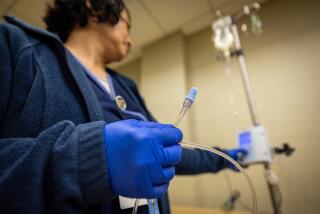Safety profile of blockbuster blood thinner comes under question
- Share via
A new investigation has raised fresh questions about a bestselling prescription medication to reduce stroke risk in those with the heart rhythm disorder known as atrial fibrillation.
Published Wednesday in the journal BMJ, a package of articles suggests that patients taking the drug dabigatran (marketed since 2010 as Pradaxa) may have a higher risk of life-threatening bleeding episodes than physicians and regulators had been led to believe.
------------
FOR THE RECORD
This post has been changed to correct the publication date of the articles in the journal BMJ.
------------
The BMJ probe also suggests that there may be safety benefits to monitoring Pradaxa’s anticoagulant effect on individual patients -- a practice deemed unnecessary by the Food and Drug Administration when it approved the medication’s marketing four years ago.
Beneath these carefully worded questions of patient safety, the authors write, lie issues of integrity and transparency in the presentation by Pradaxa’s manufacturer, Boehringer-Ingelheim, of early clinical trial data and of safety data collected since the drug hit the market. The judgment of U.S. and European drug regulators also comes in for questioning.
In an apparent bid to position Pradaxa as an improvement on a long-used medication, Boehringer-Ingelheim “withheld from the [FDA’s] regulators important analyses regarding how to use the drug as safely and effectively as possible,” wrote BMJ’s investigations editor, Deborah Cohen.
Today, millions of patients across the globe are taking Pradaxa. As of December 2011 -- about a year after Pradaxa became available -- Boehringer-Ingelheim reported that it had been notified of 9,049 bleeding events among patients taking dabigatran, including 368 deaths. Under the terms set by the FDA and its European counterpart, Cohen wrote, some of those patients may have had their blood over-thinned, raising the risk of bleeding, a problem that might have been averted had regulators required closer monitoring of patients taking the drug.
But first, a bit of explanation.
In 2010, before the blood thinner Pradaxa became a blockbuster prescription drug with annual sales worth $2 billion in the United States, it was known simply as dabigatran. Food and Drug Administration regulators fast-tracked the drug for consideration because it promised to be the first new stroke reduction treatment for patients whose heart rhythms were erratic since an anticoagulant named warfarin was introduced in the 1950s.
Pradaxa’s commercial promise turned not only on its ability to lower stroke risk in this population, but also on the practical benefits it promised to offer over warfarin.
Repurposed in the 1950s from its original use as a rat poison, warfarin’s blood-thinning effects had to be monitored with monthly or even biweekly blood draws, and could easily be knocked off-kilter by changes in diet, season and aging. Because it reduced stroke risk by lowering clotting factors in the blood, one of the unavoidable dangers of taking warfarin was the risk of spontaneous bleeding episodes or uncontrolled bleeding in cases of trauma. But patients’ unpredictable responses to warfarin -- the reason why blood monitoring is essential -- compounded these patients’ risks for such episodes.
Pradaxa also drives down atrial-fibrillation-related stroke risk by reducing the blood’s ability to clot, and so bleeding episodes remain a dangerous side effect. But Pradaxa goes about its anticoagulation task differently than does warfarin: A change in consumption of leafy green vegetables, for instance, would not alter its action, as it did with warfarin.
Compared with older, cheaper warfarin then, Pradaxa held out the promise of very practical benefits for patients, their physicians and even for health insurers: Early clinical trials presented to the FDA appeared to show that a fixed dose of dabigatran would have predictable and stable anticoagulant effects in patients. Once on Pradaxa, patients’ coagulation levels -- and hence their risks for bleeding or for stroke -- could not be knocked off course by a change in diet, season or aging. Those regular and costly trips to the lab or a physician’s office for a blood test would be unnecessary.
Since ease of use was a key selling point for Pradaxa, Boehringer-Ingelheim officials had resisted from the early days any suggestion that regular monitoring would benefit patients taking the drug. Clinical trials sponsored by the company suggested that the equal doses of Pradaxa resulted in anticoagulation levels that ranged wildly from patient to patient. But documents made public in court proceedings show that company officials debated whether publication of such analyses, or their presentation to regulators, fit with the FDA-approved marketing claims that Pradaxa required no follow-up monitoring.
Citing published studies and internal communications within Boehringer-Ingelheim, Cohen writes that dose adjustments guided by regular blood monitoring could reduce major bleeding events 30% to 40% compared with warfarin. But acknowledging that publicly would undercut one of Pradaxa’s big selling points: it’s easy to use and frequent monitoring is not required.
Boehringer-Ingelheim consistently defended its presentation of data and its decision, in some cases, not to include data showing the drug’s widely varying anticoagulation effect on patients. Asked for comment by BMJ, the company argued that it provided the FDA and its European counterpart all the clinical trial data they sought. A company spokesman acknowledged that the company did not volunteer to European regulators details of its internal debate over the potential value of blood monitoring: As they “refined their analysis,” the spokesman said, company scientists “rejected hypotheses” that they had put forth in early drafts of a paper.
Follow drug safety? Follw me on Twitter at @LATMelissaHealy.







